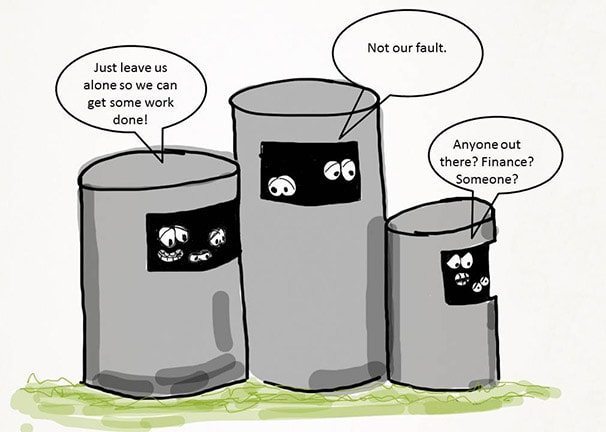What are silos? Originally tall vertical structures used to store large quantities of grain and later gaining worldwide notoriety for housing missiles capable of nuclear destruction, silos have continued in our midst for quite some time. In recent times, they stand tall within organizations, virtually even taller than the missile variety, posing as much danger to the organization’s functioning as any weapon of destruction. Though mostly virtual, and sometimes even imagined, organizations and specifically teams continue to struggle with them without success. Silo mentality, as it is more often called nowadays, refers to the phenomenon in which different teams work as if they are prisoners within one of those giant silos, not able to communicate effectively with each other.
Anyone who has worked in a corporate team would have experienced this at some point of time of the other. If it does not strike any chords, the scenario below might refresh some memories.

Source: LinkedIn
Silos have had their fair share of detractors in recent times, but let us also try to look at scenarios where they might actually be of use. Like in the original grain versions used for storage, silos of knowledge might exist, which serve the purpose of indexing huge amounts of information, without which there might be an information overload across different functions. This might be true, especially in areas, which have functional teams working on highly specialized areas requiring limited overlap. The amount of expertise needed in a subject area, might necessitate the creation of a knowledge silo, which might in fact help the overall goals of the team/organization. Or they might be useful in areas where information sensitivity is too critical to be ignored, for eg:- teams working in sensitive defense projects, intelligence agencies etc, where the age old saying” Right Hand should not know what the left is doing” still has its place.
However, in more generic situations, seen in most organizations, silos definitely exist and do more harm than good towards the overall purposes of the organization. Especially damaging are the perennial tensions and undercurrents, surprisingly common across industries, that manifest as sales vs finance teams, production vs quality, product vs sales. They key word in in all those raging cross functional debates is vs (versus). Since the vs is always taken as given, it quickly translates into a “It is either them or us” attitude, which soon takes on gigantic proportions, capable of affecting organization bottom line and employee morale. Matrix organizational structures designed to nullify the silo effect have often added to confusion regarding roles and team memberships so much so that it resembles the convoluted mazes represented in “The Matrix” movie!

Source: Flickr
If silo mentality is so damaging, what are some of the simple things that teams can do to work effectively in their presence?
Acknowledge their presence:
This seemingly innocuous first step is easier said than done. In groups that I have worked with, experiential activities have been very effective in bring about this realization within the team. Any task which involves multiple teams to take up different projects, and ultimately coming together for the common objective of the team is usually useful in this regard. Construction-ism exercises, which involve teams working together to build something can be used for a simple illustration. After dividing teams into groups, a task is assigned to the teams to construct a structure (could be a tower using day-to-day materials, Lego etc). Half way through the exercise, make the teams stop their work, and move on to the next group and complete their work! Even when groups move to clearly superior structures created by other groups, there is still a discernible sense of sadness and murmuring about their previous structures being better and more importantly, teams attach a sense of ownership to the structures they had started work on. If this is the case in a 45 minutes exercise, imagine how difficult it would be to move out of silos in an organizational setting, where people have made domains their own over the course of years!
Seek common ground:
Clearly, the omnipresent skirmishes between different functional groups are not easy to eliminate completely, but trying to seek common ground can go a long way in at least bridging silos. While production vs quality struggles are the stuff of legend in most organizations, an open discussion between stakeholders emphasizing the ultimate objective of both the team, of “delivering maximum number of products that add value to the consumers” in this case can be a good starting point. In a team building workshop, experiential activities can again be used to highlight this point. As an illustration, consider any exercise, where the objective (though not explicitly stated) needs the teams to collaborate for success. By skillful facilitation, the teams can grasp this learning pretty quickly. Needless to say, doing the activity is but just a starting point. It needs to be translated to the work place in clear, actionable steps for the teams to work on from a long-term perspective. Clearly, there is a lesson to be learnt in terms of organizational goal setting, which can be molded to have success of teams interdependent on others, and spreading awareness about it.
Bridging Silos:

Source: LinkedIn
This stream of thought is steadily gaining ground amongst HR practitioners and academia alike, the basic concept being to connect organizational silos instead of attempting to break their rigid structures. Ranjay Gulati, of Harvard Business School, talks about a 3-pronged approach for connecting silos in his recent publication, “Reorganize for resilience”. The author suggests 3 areas of action, empowering (sharing of information amongst departments to avoid locking up of information); Hire (hiring people with a collaborative mindset instead of solo sharpshooters) and Reward (specifically rewarding collaborative behaviors). Clearly, the theory holds merit, but like any other, needs the blessings of top management, and a crystal clear focus on execution. In the author’s recent interview with Livemint, he shares his thoughts on the subject in detail: Encourage your staff to bridge silos
Goal Setting:

Source: Pixabay
Having team goals instead of individual performance parameters can also go a long way in connecting silos within organization. Motivational author Daniel Pink (in his recent work, “DRIVE: What motivates us”), talks about research data in this domain, pointing that out that employees who were allowed leeway to set their own targets outperformed the top-down approach where goals were handed down, military style without discussion or debate. His perspectives on the same are excellent, more details on the book can be viewed here, DRIVE.
Taking the argument one step further, if teams are allowed to set their own goals, the energy and passion with which they pursue the achievement of the same goals, would surpass the top down goal setting approach. So consider this scenario: what if you could give the same goals to both production and quality departments, as an example “Produce xxxx units of this product adhering to the xxx quality parameters”. Sales and marketing departments also could have goal setting, with marketing initiatives being measured on additional sales generated by a particular marketing campaign, in which clearly the focus shifts from spending budgeted marketing $ in any way fit to ” how do we optimize the marketing spend to generate additional revenue”.
Clearly, addressing the silo effect is not easy in an organizational setting, but the perils of ignoring it far outweigh the challenges in addressing them. The road ahead is fraught with pitfalls, but faster the teams become aware about the presence of silos, and work in a concerted manner to connect them, the better they would be able to work effectively together in pursuit of organizational goals.
Do share your thoughts/experiences on the subject as well.
